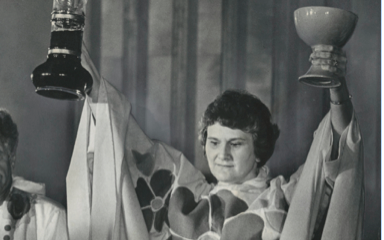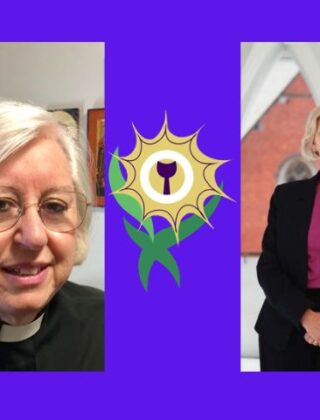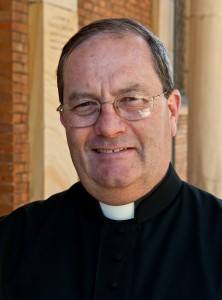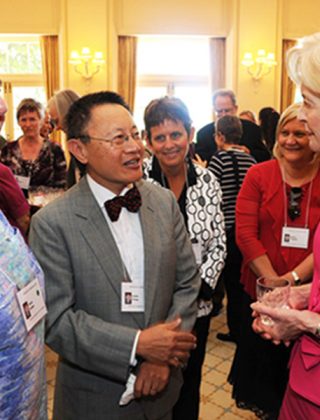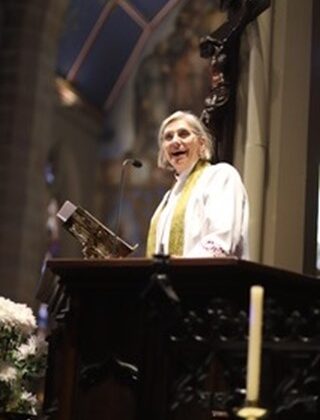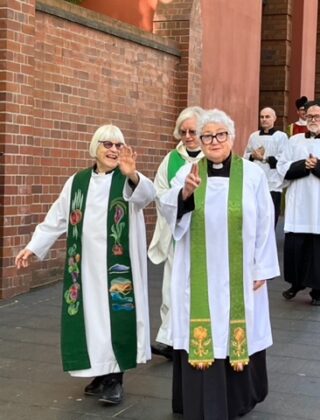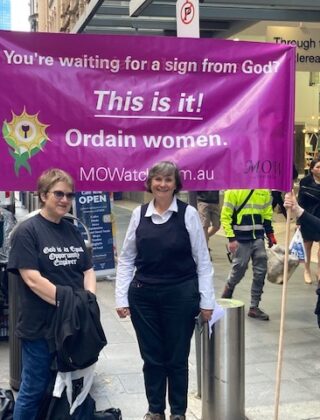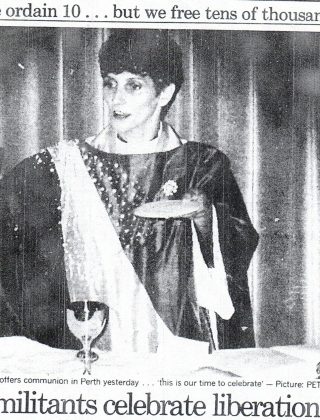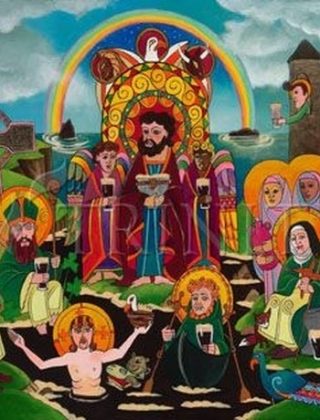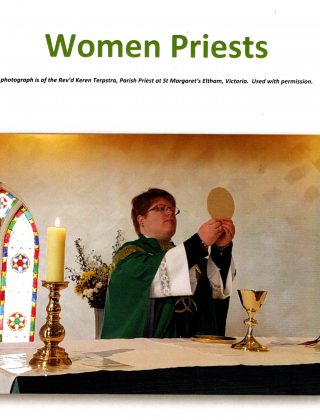Sydney MOW AGM 2015 President’s Report
|
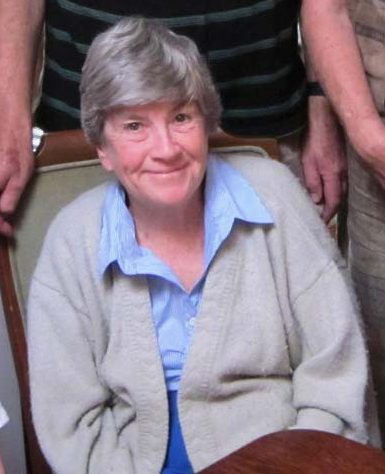
This twelve months since my 2014 Report has flown by. Have we made any headway towards our
goal of ordination to the three-fold orders of women in the Sydney Diocese? No, there is no
perceptible change. Are we an alternative voice within this Diocese? Yes, we are. Should we be
satisfied then? No, I think not. Should we learn how to live with difference and accept divergent
views of church? Maybe that would be helpful. How do we best survive in a church culture which is
against us and sees us as seriously misguided? Good question! How do we survive in a church culture
that has erected a steel wall around itself to keep us excluded? These are some of the questions
that confront us as members of MOW Sydney.
Firstly I want to acknowledge the great support of the Sydney MOW Committee, and also the
members of the MOWatch National Board, including Jeannette McHugh our National President,
here today. Thank you to our members too, who are present with us. You are both an
encouragement and an inspiration. You are willing to be counted as people who believe that
ministry in God’s church is not complete and whole until women along with men, may be ordained
to the priesthood and may then be consecrated as Bishops. Leadership in the church needs to be
opened up to the other 50% of the population.
There are a number of issues that I would like to touch on in this Report. I will attempt to keep to a
chronological order for ease of reference. Many of you here today would have been among those
who heard Keith Mascord’s “Breaking the Stained Glass Ceiling” address in February at All Saints,
Hunters Hill. His reasoned argument enlightened us, and so helped us grapple with the theology and
disturbing gender views of the diocese. The following week some of us were fortunate to hear Kevin
Giles deliver his lecture to CBE, “The Most Important Text in the Bible: The Genesis of Equality”.
Christians for Biblical Equality (CBE), has been for me, a helpful ecumenical organisation to link up
with, its articles and events giving a sound theological basis for men and women being one in God’s
sight, even though it is not specifically focused on women’s ordination as MOW is.
In the same month, February of this year, we heard of the very sad and unexpected death of Bishop
Barbara Darling, the second female Bishop consecrated in Australia (in 2009). In that Bishop Barbara
had originally come from Sydney, we felt in a way that she was one of us. We were pleased that our
Sydney Archbishop, the Rt Rev’d Glenn Davies gave a tribute on behalf of his bishop colleagues, and
yet on hearing it we felt a definite sense of dislocation, because his remarks as expressed on that
occasion did not match our experience of Anglican ministry within this Diocese.
It has been a great joy to us here in Sydney to hear news of other female Bishops across the nation.
Bishop Kay Goldsworthy’s appointment as the Bishop of Gippsland, now brings female Diocesan
bishops to two. The consecration recently of the Rev Canon Kate Wilmot as Assistant Bishop of Perth
to replace Bishop Kay there, brought the total of female Australian Bishops back to five.
Bishop Genieve Blackwell, also originally from the Sydney Diocese where she had been a Deacon,
transferred from Assistant Bishop in the Diocese of Canberra-Goulburn to Assistant Bishop in the
Diocese of Melbourne.
We rejoice when we hear of these developments, but they all the more keenly heighten our sense
of despair in Sydney where a female ordained to priests’ orders, let alone a woman consecrated
bishop will not be recognised. A female bishop may not wear her robes here, nor will she receive an
invitation to a Bishop’s consecration here. Our Archbishop calls this state we are now in as impaired
communion. I call it a divided church. What else is it when bishops and priests of the one church are
not recognised by the total communion?
Is there a way out of this dilemma? Is finding a solution an impossibility? I spoke of a steel wall.
The steel is admix of Sydney Synod, the Anglican Church League, the Diocesan Standing Committee, and
Moore College. The flying buttresses are institutions like Matthias Media, Equal but Different,
Priscilla and Aquila, the Fellowship of Confessing Anglicans and the Gospel Coalition. And then the
cap around all of them is GAFCON, an international conservative body, principally led by the Sydney
Diocese, which exists to replace Lambeth. Sydney now firmly locates its allegiance to the
conservatives worldwide, and seems to be more at home there than with the Australian national
church. All the above institutions and supporting institutions hold on to complementarian theology:
that the female must submit to the male both in church and marriage, and therefore females cannot
be in a leadership role.
Welcome to the fortress but do we give up? No. But what is a strategic and sensible way forward?
When there is perceptible difference in any relationship, keeping the dialogue open is imperative.
One initiative that has been undertaken is to bring a group of people together who believe that even
though views of churchmanship may differ, discussion of ways to create openness and acceptance
is positive. An initial meeting of fifteen men and women across the Diocese has taken place and it is
hoped that this will lead to an open forum event in the new year.
An improvement in our general communication has also been a priority. Angela Peverell has worked
with Kathleen Toal to update both the national MOWatch and the Sydney MOW websites, and also
there are regular posts on the Sydney MOW’s Facebook site. We have over 145 followers now on
Facebook. The post about Kate Wilmot’s consecration as Assistant Bishop of Perth earlier this month
received 1.2K hits, proving people know wearer out there; however we don’t know how many of
these may be Sydney Anglicans. We are grateful for Anglicans Together being willing to advertise
our events on their website which is targeted to Sydney “stole” parishes, but we need to find ways
of reaching people in Sydney whose only experience of church is Sydney Anglicanism, and thereby
knowledge of their national church tending to be negative.
Earlier in the year, the secular media had Sydney Anglicans in its sights when Julia Baird and others
were highlighting the issue of domestic abuse and mentioned that the teaching of submission of
women to men in our churches created a climate for abusive relationships. At least one counsellor,
writing in the Sydney Morning Herald, mentioned that women from within the Sydney Anglican
church were among those who had come for help with domestic violence issues, and omplementary
theology was dangerous. There has been since an edition of Southern Cross focusing on domestic
violence, but it skirts this diocesan theology.
Complementarianism, in that it means the male must be the head, the authority, reeks of power
delineated by gender. This does not speak of the new creation that Christ has inaugurated. It does
not speak of the servanthood of Christ. It does not speak of the freedom of the Gospel. Nor does it
speak of the Holy Sprit’s power coming upon us to lead us to new and wholesome ways of being
God’s people.
Until the complementarian theology can be dealt a death blow, it is most likely that the structures
in the Diocese to keep women out of ordination, except to the Diaconate, will remain.
Complementarian theology is the cement slab to which the steel, mentioned above, is bolted.
Complementarianism is embedded in the Sydney doctrine of the Trinity, i.e. that the Son is in eternal
submission to the Father. This may well be heresy. It is an extraordinary leap, a slight of hand, to
thus believe that therefore a woman’s place is in submission to a man in church and marriage, and
surely incongruous to believe that this order need not however, be adhered to anywhere else in
society.
How can a church’s teaching be based on such a fallacy? It is also extraordinary that women in this
diocese believe it, and books defending it are written by women which are read and extolled by
women and men alike. How do we disseminate a different view on this?
I am also interested in exploring for myself why the scriptures as presented in the gospels, as
compared to the scriptures as presented in the epistles, particularly the Pauline epistles, seem to
demarcate the line between the Sydney Diocese (and I include here the Sydney Diocesan satellites
of The North-West and Armidale) and the rest of the national church. At a retired clergy lunch that
I attended, the Archbishop mentioned that parishes outside of Sydney preach on the Gospels – that
they are less likely to preach on the epistle set for the day as do Sydney. I agree that that is more
often than not the case, although I have nearly always endeavoured to integrate both when preach.
I was interested then that Dr Daniel Kirk, in his recent lectures for CBE, addressed this gospel/epistle
issue, though not in terms of Diocesan difference. Maybe a way of approaching the
complementarian/egalitarian divide is exploring the gospel/epistle difference and how this is
mirrored in the national/Sydney divide? In that the Gospel writers who recorded our Lord’s words,
and Paul in his epistles, teach and elucidate the same Gospel of Good News, then maybe exploring
why this polarity has come about could be a way forward to assist future cohesion.
I shall conclude with a personal comment. Although I am licensed in this Diocese as a Deacon, my
Priesthood remains who I am, my identity. The Diocese can’t remove what has become my inner
being. Does it make any difference to ministry if you are ordained priest? Yes, it does – both for
pastoral and for liturgical ministry. That the Sydney Diocese is blind to this fact as it applies to
women is a great shame. O Lord, open the eyes of the blind and the ears of the deaf, that all people,
both lay and clergy, may see your glory and hear your call, so realising their gifts to serve. We pray
especially that women may be allowed to use their God-given gifts without restriction, and so be
ordained as deacons and priests, and consecrated bishops in your church. We pray that you would
graciously bless all members of MOW Sydney with wisdom for the task you have set us.
Through Jesus Christ our Lord, Amen.
The Rev’d Lu Piper OAM 29.8.2015



